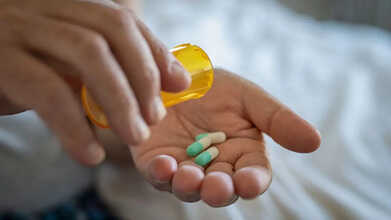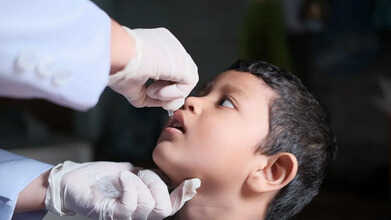- Health Conditions A-Z
- Health & Wellness
- Nutrition
- Fitness
- Health News
- Ayurveda
- Videos
- Medicine A-Z
- Parenting
- Web Stories
Legionnaires’ Outbreak Canada: 94 Sick So Far, Ontario Food Manufacturer's Cooling Tower Could Be Source Of The Deadly Disease

Credits: Canva
Legionnaires Outbreak: Public health officials in London, Ontario, have redeclared a Legionnaires’ disease outbreak after 25 new cases emerged, weeks after declaring the situation under control. The Middlesex-London Health Unit (MLHU) confirmed Tuesday that testing has identified a likely source: cooling towers at Sofina Foods Inc., a large meat-processing facility on Trafalgar Street.
Outbreak Declared Over, Then Returned
The outbreak was first detected in early July and by early August had led to 70 confirmed cases and three deaths. After three weeks without new infections, the MLHU declared the outbreak over on August 6. But within days, new patients began appearing.
As of this week, the caseload has climbed to 94, including 86 hospitalizations and four deaths. Six patients remain in hospital. Officials say the resurgence highlights how the bacteria can persist in contaminated environments despite earlier cleaning efforts.
“For several weeks, no additional illnesses were reported, and we were optimistic that remediation efforts had eliminated the bacteria. However, 25 more people have now become ill,” said Dr. Joanne Kearon, associate medical officer of health. “Fortunately, a likely source has now been identified.”
Read: Legionnaires Outbreak in New York: All That You Need To Know About The Disease
Cooling Towers Traced as the Source
Extensive environmental testing linked the outbreak strain of Legionella bacteria to Sofina Foods’ cooling towers. Samples taken in recent weeks matched the same bacterial subtype found in patient cases.
While nine different cooling towers across the city initially tested positive for live bacteria, the Sofina plant produced a definitive genetic match. Earlier testing at the site in 2024 and early 2025 had shown no match, but officials said the bacteria can survive in cooling towers and regrow under hot, humid conditions.
The health unit emphasized that food products from Sofina remain safe to consume, since Legionnaires’ disease spreads only through inhaling contaminated water droplets, not through eating or drinking.
Sofina Foods Responds
Sofina Foods, which employs hundreds of workers in London’s east end, said the new findings were “unexpected” given the company’s daily sanitation protocols and previous negative test results.
“We are deeply concerned with this new information and are continuing to investigate fully,” said Sharon Begley, Sofina’s chief safety officer. “Over and above our regular processes, we conducted further deep cleaning and disinfecting processes recommended by MLHU. The cooling tower is offline and will remain offline until these additional steps are completed.”
The company stressed its commitment to employee and community safety, noting it has been cooperating closely with public health authorities since the outbreak began.
How Legionnaires’ Spreads
Legionnaires’ disease is a severe form of pneumonia caused by Legionella bacteria. It is not transmitted from person to person. Instead, people get sick when they inhale mist or small droplets of water containing the bacteria, which can be carried by wind from sources such as cooling towers, hot tubs, and water systems.
Symptoms typically appear within 2 to 10 days of exposure and may include fever, chills, cough, muscle aches, and shortness of breath. Most exposed individuals do not get sick, but older adults, smokers, and people with weakened immune systems face greater risk of serious illness.
The current outbreak has been concentrated in a six-kilometre radius in London, with cases ranging from young adults to seniors. No children have been affected to date.
Also Read: Legionnaires' Outbreak Update: It Is No Longer 'Only A New York Problem'
More Cases Possible
Dr. Kearon warned that more cases could surface due to the bacteria’s incubation period. “Legionella has an incubation period of two to 10 days ... there may still be further cases in the next two weeks,” she said.
This year’s outbreak is already the largest in London’s recent history, surpassing a 2024 outbreak that caused 30 cases and two deaths. Officials say they are working with Sofina Foods and other operators to ensure thorough remediation and prevent further spread.
“The decision to reopen the outbreak reflects a rise in cases after several weeks without new cases, suggesting that the Legionella bacteria has re-emerged in the environment despite earlier remediation efforts,” MLHU said in a statement.
Also Read: Michael Clarke Reveals Skin Cancer Surgery, Sparking Urgent Reminder: How To Spot The Signs Early?
Atorvastatin Recall: Popular Cholesterol Medicine Pulled From Pharmacies – What You Need To Know

Credits: Canva
Over 140,000 bottles of a prescription statin have been pulled from the market due to “failed dissolution specifications,” according to a report by the U.S. Food and Drug Administration (FDA). Ascend Laboratories, based in New Jersey, recalled Atorvastatin Calcium, a generic version of Lipitor, manufactured by Alkem Laboratories of India and distributed across the country. The recall covers tablets in 90-count, 500-count, and 1,000-count bottles with expiration dates extending to February 2027.
Atorvastatin Recall: Why Is The Popular Cholesterol Medicine Being Recalled?
On October 10, 2025, the FDA classified the recalled drug as a Class II recall. This classification means the medication could cause “temporary or medically reversible adverse health effects,” though the likelihood of serious harm is considered “remote.”
Statins are widely prescribed to manage high cholesterol and to prevent or reduce heart disease, according to a 2023 study from Florida Agricultural and Mechanical University.
Dr. Tamanna Singh of the Cleveland Clinic noted on a September podcast that roughly “39 million adult Americans” take statins, with the largest group being over 40. She added that Lipitor, Crestor, and their generics, atorvastatin and rosuvastatin, are the most commonly prescribed medications in this class.
Atorvastatin Recall: Why This Cholesterol-Lowering Drug Recall Matters
Most drug recalls are initiated by the manufacturers themselves, and this appears to be the case here. The recalled product is made by New Jersey-based Biocon Pharma, Inc. “Recalls are typically initiated voluntarily by companies before they notify the FDA,” explained Dr. Ileana Elder, Branch Chief in the Incidents, Recalls, and Shortages Branch at the FDA’s Center for Drug Evaluation and Research, in a 2024 Q&A.
Atorvastatin Recall: What Should People Do With the Recalled Medication?
Neither the FDA nor the companies have issued detailed instructions on handling the recalled tablets. GoodRx advises anyone affected by a recall to check their medication’s lot number, contact their pharmacy, reach out to their prescriber, and properly dispose of the recalled medication.
Statins like atorvastatin are among the most commonly prescribed drugs for lowering “bad” cholesterol and reducing heart disease risk, meaning many adults could be affected. A failure in dissolution means the medication may not deliver the correct dose, which can compromise treatment effectiveness, particularly for those relying on consistent cholesterol control.
The recall being classified as Class II (risk of temporary or reversible harm) highlights that the risk is serious but not immediately life-threatening. Because generic medications are widely used and often more affordable, many patients may not realise their specific bottle is impacted and may continue taking it, assuming it is safe.
Atorvastatin Recall: How to Check if Your Bottle Is Affected
Check your prescription bottles for the manufacturer, lot number, and bottle size listed in the FDA notice.
If your medication is part of the recall, do not stop taking it suddenly—contact your healthcare provider for guidance and request a replacement or alternate formulation. Keep any affected bottles separate, and avoid sharing your medication, as only specific batches have been flagged. Always store your medications correctly, and check with your pharmacy at each refill to ensure the lot and manufacturer are free of recalls.
Why Iceland Is Witnessing Mosquitoes For The First Time In History

Credits: Canva
Iceland, one of the last regions in the world without mosquitoes, has recorded its first sightings of the insects following an unusually warm spring. The discovery was confirmed by the country’s National Science Institute on Monday, October 20, 2025. The sightings come after a record-breaking summer that accelerated glacial melting across Iceland.
Insect enthusiast Bjorn Hjaltason noticed the mosquitoes over several nights last week while observing moths using wine-soaked ropes, local media reported.
When Were Mosquitoes Detected in Iceland?
On October 16, Hjaltason shared on a Facebook group that he had spotted mosquitoes at dusk in Kidafell, Kjos. He captured some using a red wine ribbon, a trap that attracts insects with sweetened wine.
Kjos is a glacial valley about 52 km (32 miles) northeast of Reykjavik, Iceland’s capital. Hjaltason sent his specimens to the Natural Science Institute of Iceland, where entomologist Matthias Alfredsson confirmed they were indeed mosquitoes.
Climate Change Leading To Mosquito Discovery In Iceland
“The recent mosquito sightings in Iceland are likely linked to climate change,” said Carla Vieira, a scientist studying mosquito-borne viruses at QIMR Berghofer Medical Research Institute in Australia, according to The Washington Post. “Rising global temperatures and milder winters create conditions where mosquitoes can survive and reproduce in areas that were previously too cold.”
The Natural Science Institute said it’s unclear how these mosquitoes arrived in Iceland. “It’s possible they were transported via freight,” the institute stated. “Whether they’ve permanently settled here is uncertain, but conditions suggest they could survive.”
A report by Al Jazeera notes that Iceland is warming faster than almost anywhere else. In May 2025, Iceland and neighboring Greenland experienced extreme heat caused by a persistent weather pattern bringing unusually warm air from the south. Temperatures were about 13°C (23.4°F) above the 1990–2020 average, ten times higher than the global average increase of 1.3°C (2.3°F).
Glaciers have been melting rapidly and are projected to lose nearly half their volume by 2100, according to Iceland’s Vatnajokull National Park website.
However, some experts caution against quickly attributing the mosquito discovery to climate change. Alfredsson and epidemiologist Colin J. Carlson from Yale University points out that while climate change may have made the sightings more likely, the full picture of mosquito range shifts remains unclear.
Which Type Of Mosquitoes Have Been Found In Iceland?
Alfredsson identified the species as “Culiseta annulata,” a cold-resistant mosquito native to the Palearctic region, which includes Europe, North Africa, and much of Asia north of the Himalayas. These mosquitoes are not known to carry disease, though they can be bothersome.
“They survive cold climates by hibernating as adults in sheltered spaces like basements or outbuildings,” the Natural Science Institute said. “They bite but are not considered dangerous to humans in these regions, as they carry no known infections. Mosquito species adapted to cooler climates generally don’t transmit diseases.”
Can Mosquitoes Survive In Iceland?
It is not known yet whether these mosquitoes will establish permanent populations in Iceland. Philip Weinstein, an infectious diseases researcher at the University of Adelaide, believes Iceland’s harsh winters may be too challenging, even for a cold-adapted species. On the other hand, Gisli Gislason, professor emeritus of limnology at the University of Iceland, thinks the mosquitoes may settle in.
Further monitoring will be needed to determine the outcome. If these mosquitoes do establish themselves, only Antarctica would remain free of the pesky insects.
World Polio Day 2025: Date, Theme, And Why Eradication Still Matters For Global Health

Credits: Canva
Polio is a contagious viral illness that can lead to paralysis, making its complete eradication important to protect every child from lifelong disability, a mission recognised each year on World Polio Day. This global observance aims to spread awareness about the dangers of polio and the continued worldwide push to end the disease.
The day also serves as a platform for governments, health organisations, and communities to reflect on the progress achieved so far, identify ongoing challenges, and strengthen collective efforts toward a polio-free world. Let’s take a look at when World Polio Day is observed and what this year’s theme focuses on.
Why Is World Polio Day Celebrated?
World Polio Day, observed every year on October 24, aims to raise global awareness about the importance of eradicating polio and maintaining immunization efforts. Recognized by organizations such as the World Health Organization, Rotary International, and UNICEF, the day celebrates the progress made against polio while highlighting the work still needed to protect children from this potentially life-threatening disease.
It brings together governments, communities, educators, and health workers in a shared effort to support a polio-free world, underscoring the power of vaccination and the importance of collective action in public health.
World Polio Day: History and Origin
World Polio Day was created to honor Dr. Jonas Salk, who developed the first effective poliomyelitis vaccine. The observance was officially initiated by Rotary International and is now supported by the Global Polio Eradication Initiative (GPEI), which includes key partners like WHO and UNICEF. The day not only commemorates vaccine breakthroughs but also continues the global fight to end polio, a disease that once paralyzed hundreds of thousands of children annually. Thanks to worldwide vaccination campaigns, most of the world is now polio-free, though efforts continue in regions where the virus still exists.
World Polio Day 2025 Theme
This year’s theme, End Polio: Every Child, Every Vaccine, Everywhere, emphasizes the urgent need to vaccinate every child and ensure equal access to protection against polio. It is a call to action for global eradication, highlighting both the responsibility and commitment required to make a polio-free world a reality.
How Does Polio Spread?
Polio is mainly transmitted through the faecal-oral route, meaning it spreads when a person consumes food or water contaminated with the virus. It can also spread through close contact with an infected individual. The poliovirus lives in the throat and intestines of those infected, and poor sanitation, unsafe water, and inadequate hygiene greatly increase the risk of transmission, especially in communities with limited access to clean facilities.
In severe cases, polio can lead to acute flaccid paralysis, which may affect the diaphragm and throat muscles, making it difficult to breathe or swallow. Since there is no cure for polio, prevention remains the only line of defence. Raising awareness about polio vaccination is therefore essential to protect individuals, especially children, from this potentially life-threatening disease.
© 2024 Bennett, Coleman & Company Limited

